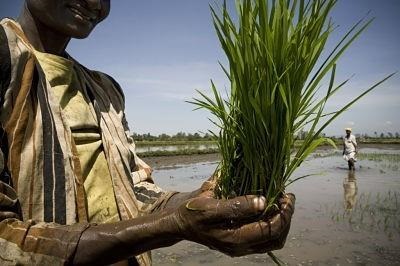Rice revival gives Kenyan community hope
At the height of the 2008 food price crisis, FAO, through its Initiative on Soaring Food Prices (ISFP), launched a series of one-year input supply projects to help vulnerable farmers grow more food and earn more money. In Kenya, where civil unrest, drought and high food, fuel and input prices have left poor families even more vulnerable, this assistance has given one community hope for a better future.
Ahero, Kenya - This September, the rice fields in Ahero - a rural community in south-western Kenya - were abuzz with activity.
Across the more than 2 000 acres that make up the Ahero Irrigation Scheme, women and men were levelling their land and transplanting rice seedlings.
Expectations are high that the upcoming harvest will rival the bumper crop gathered earlier this year. With yields doubling - even tripling - over previous years, there is now "competition to see who gets the most bags per acre," said Richard Arodi, 75, a farmer and head of one of the scheme's 30 farmers' groups.
The success of last season's rice crop has pumped new momentum into this community of 20 000. There are more jobs now and more money is flowing through the local economy.
‘Ahero was like a ghost town'
Just over a year ago - before FAO provided inputs to Ahero farmers to help jumpstart rice production - the scene was very different.
Only a fraction of the scheme's 2 168 acres were under cultivation - and output was low, with farmers increasingly hamstrung by the high cost of seeds, fertilizers and fuel.
"They hadn't had a good rice crop in eight or nine years," said Dr Paul Omanga, FAO-Kenya National Consultant for Crop Production. "They were vulnerable."
Poverty levels in Ahero are high and the spread of HIV has taken its toll on the community. Before the current rice boom, most survived on what they could grow from tiny plots of land near their homes or by selling off livestock and other assets. Parents, unable to afford school fees, were often forced to take children out of school.
Fall-out from post-election violence coupled with the global surge in food and fuel prices in 2007-2008 made matters worse.
"Before the rice project started, we were getting a little money to buy maize or millet, but we couldn't even buy one full sack," said Karen Awuor, 47, a widowed mother of seven. "Sometimes, we were just drinking water and then sleeping because there was no way at all."
With few money-making opportunities around, especially for young people, "Ahero was like a ghost town," said Dr Omanga.
Revival of rice farming
An earlier FAO investment of two new water pumps helped to revive the Ahero Irrigation Scheme, which had collapsed in the late 90s.
To reverse the scheme's low output, FAO, in September 2008, worked closely with Kenya's National Irrigation Board (NIB), the Agriculture Finance Cooperation (AFC) and the Rural Environmental Care for Africa (RECA) to provide 540 farming families with high-yielding rice seeds, fertilizers, pesticides and technical assistance.
They helped the farmers to organise into smaller groups and connected them to service providers including banks and equipment rental.
First bumper crop in years
Thanks to a robust local and regional market for rice, bigger yields from this last harvest meant bigger profits.
In one season alone, farmers earned between KS100 000 - KS250 000 each (roughly USD1 600 - USD3 300) - about seven to eight times what they made in the previous year.
Local traders bought more than half of what was produced in Ahero, while others came from elsewhere in Kenya and from nearby countries. The World Food Programme (WFP) bought about 40 metric tonnes, which they distributed to drought-affected communities in Kenya's Rift Valley. It was the WFP's first purchase in Kenya under the newly launched "Purchase for Progress" (P4P) - an initiative to link low-income farmers with markets.
Maintaining momentum
Ahero farmers have begun to see farming as a business and have taken steps to becoming self-sufficient, including setting up a revolving credit fund to finance the purchase of inputs.
But they need additional training on everything from group governance and financial management to collective marketing and improved farming techniques. They also need better machinery and processing equipment to help reduce costs and make their rice more competitive, and a gravity-fed irrigation system to eliminate their dependence on electricity used to pump water from the river.
Such investments could go a long way to ensuring Ahero's success in reducing poverty, according to John Mike Ocharo, 73, a farmer and chair of the scheme.
"If we can have a bumper harvest like the last time, then we will be okay," he said. "Ahero will be okay in five years."
Investments in agriculture key
At a time when Kenyans throughout the country are being made more vulnerable by drought and other shocks, the need for greater investments in agriculture is all the more pressing.
"Most of the time we are just fire fighting, responding to an emergency with food aid, cash transfers or inputs for just one season," said Castro Camarada, FAO Representative for Kenya. "And, in two to three years, when there is another shock, we are back to the same situation."
"We need to pay more attention to long-term investments in the agriculture sector, including water storage for drier areas, irrigation, crop diversification and market linkages," he added. "I think then, within five to ten years, we could significantly reverse the situation.
6 November 2009
